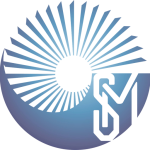Speaker
Description
Recently, borate glasses have been widely investigated due to their unique qualities such as high optical transmission, low refractive index, and high thermal expansion coefficient [1]. Due to these characteristics, such glasses are suitable for being doped with trivalent lanthanides to explore potential laser applications. For this purpose, Nd3+, characterized for possessing near infrared emissions at 0.88, 1.06 and 1.34 µm, is a suitable ion to be embedded in a borate glass. Various theoretical and experimental studies show that it is possible to generate a 1.06 µm laser [1-3]. This work is devoted to study the spectroscopic and structural properties of a novel 10Al2O3-70Na2O-20B2O3 invert glass, activated with different contents of Nd3+. XRD patterns confirm the vitreous nature of the samples in all doping range. FTIR spectroscopy reveals that the main vibrational groups correspond to borate tetrahedra (BO4) and trihedra (BO3). The absorption coefficient spectra present bands related to Nd3+: 4I9/2 → 2P1/2, 2D3/2 + 2G9/2 + 4G11/2, 4G5/2 + 2G7/2, 2H11/2, 4F9/2, 4F7/2 + 4S3/2, 4F5/2 + 2H9/2 and 4F3/2 transitions. Within the framework of Judd-Ofelt theory, the experimental (fexp) and calculated (fcal) oscillator strengths are calculated, as well as the intensity parameters Ω2, Ω4, and Ω6, associated with the asymmetry, viscosity, and rigidity of the glass. Additionally, radiative parameters such as calculated (βcal) and experimental (βexp) branching ratios, radiative emission probability (AT), cross-section (σp), among other, are calculated to validate the potential usefulness in 1.06 μm laser applications. The emission spectra, measured under 808 nm excitation, present three bands corresponding to the transitions 4F3/2 → 4I9/2, 4I11/2, and 4I13/2, being the 4F3/2 → 4I9/2 (1.06 μm) one the most dominant. Finally, the lifetime profiles are analyzed by using the Inokuti-Hirayama model, showing that the main interaction mechanism corresponds to a dipole-dipole interaction within the Nd3+-Nd3+ clusters.
Reference
[1] https://doi.org/10.1016/j.jnoncrysol.2021.121085
[2] https://doi.org/10.1364/OE.468607
[3]https://doi.org/10.1016/j.jlumin.2021.118216
This work was supported by
Cátedra de Investigación Marcos Moshinsky, CONAHCYT
| Keywords | Inverted glass, Neodymium, Luminescence, spectroscopy, oscillator strengths |
|---|---|
| Author approval | I confirm |
| Author will attend | I confirm |

